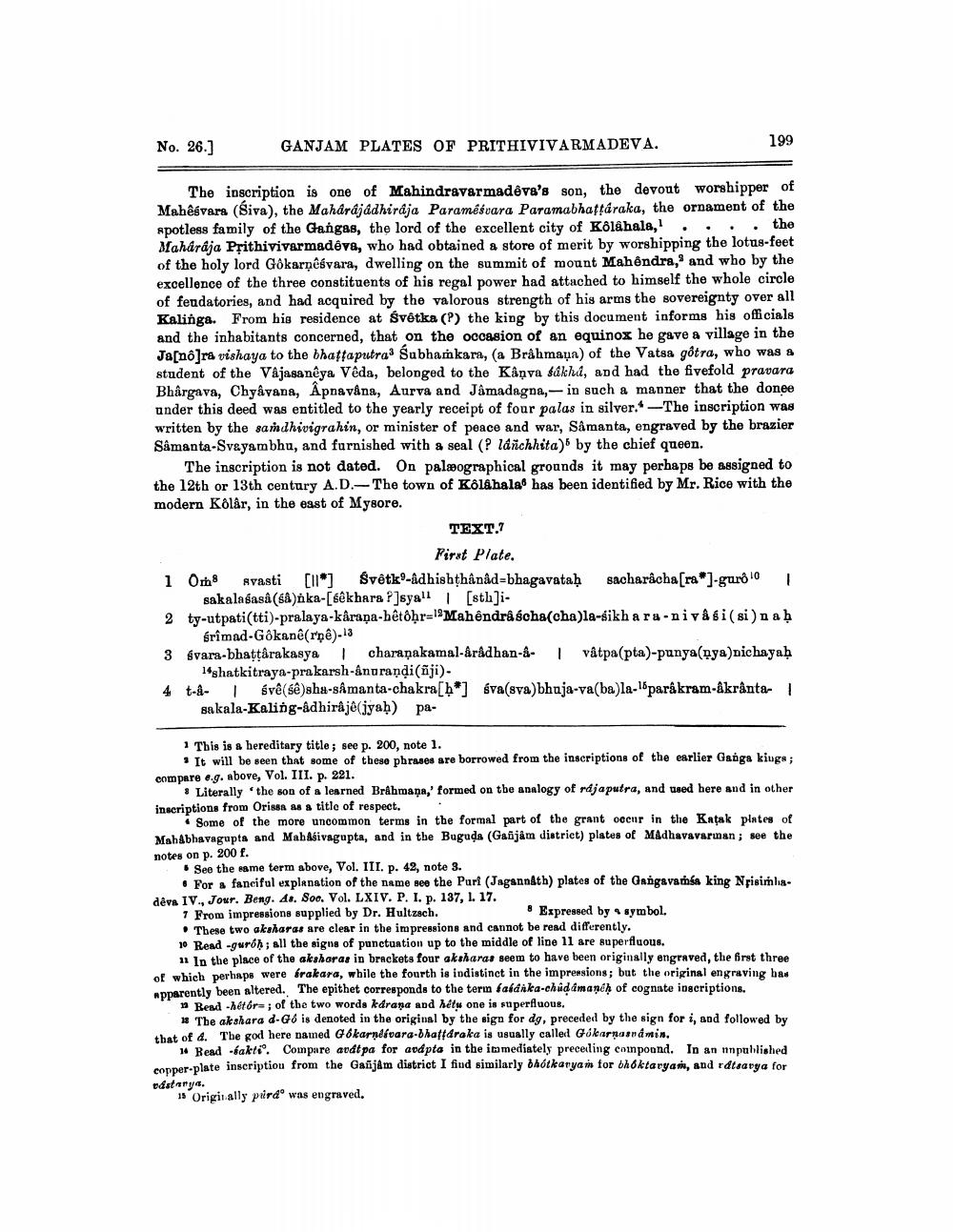________________
No. 26.]
GANJAM PLATES OF PRITHIVIVARMADEVA.
199
The inscription is one of Mahindravarmadêva's son, the devout worshipper of Mahêsvara (Siva), the Maharajadhiraja Paramégvara Paramabhaftáraka, the ornament of the spotless family of the Gangas, the lord of the excellent city of Kôlâhala, . . . the Maharaja Prithivivermadeva, who had obtained a store of merit by worshipping the lotus-feet of the holy lord Gokarnesvara, dwelling on the summit of mount Mahendra, and who by the excellence of the three constituents of his regal power had attached to himself the whole circle of feudatories, and had acquired by the valorous strength of his arms the sovereignty over all Kalinga. From his residence at svétka (?) the king by this document informs his officials and the inhabitants concerned, that on the occasion of an equinox he gave a village in the Ja[no]ra vishaya to the bhattaputra Subhankara, (a Brahmaụa) of the Vatsa gôtra, who was a student of the Vâjasa nêya Veda, belonged to the Kâņva såkhi, and had the fivefold pravara Bhargava, Chyâyana, Apnavána, Aurva and Jâmadagna, in such a manner that the donee under this deed was entitled to the yearly receipt of four palas in silver.* -The inscription was written by the sandhivigrahin, or minister of peace and war, Samanta, engraved by the brazier Samanta-Svayambhu, and furnished with a seal (? lánchhita) by the chief queen.
The inscription is not dated. On palæographical grounds it may perhaps be assigned to the 12th or 13th century A.D.-The town of Koláhala has been identified by Mr. Rice with the modern Kölâr, in the east of Mysore.
TEXT.7
First Plate. 1 Oth8 Avasti [11] Svētko-adhishthânåd=bhagavataḥ sacharacha[ra*]-gurôl
sakalabasa(SA)nka-[sêkhara P]syal | [sth]i2 ty-utpati(tti)-pralaya-käraņa-bêtôẠr="Mahendra scha(cha)la-sikhara-nivå si (si)n aḥ
frîmad-Gôkane(rne).13 3 svara-bhattârakasya | charaṇakamal-årådhan-&- I våtpa(pta)-punya(nya)nichayaḥ
14shatkitraya-prakarsh-Anurandi(õji). 4 t-a- évê( sê)sha-sâmanta-chakra[h*] śva(sva)bhaja-va(ba)la-paråkram-akranta-
sa kala-Kaling-adhiraje(iyah) pa
1 This is a hereditary title; see p. 200, note 1.
. It will be seen that some of these phrases are borrowed from the inscriptions of the earlier Ganga kiugs; compare e.g. above, Vol. III. p. 221.
Literally the son of a learned Brahmaņa,' formed on the analogy of rdjaputra, and used here and in other inscriptions from Orissa as a title of respect.
• Some of the more uncommon terms in the formal part of the grant oeenr in the Katak plates of Mshábhavagupta and MabAsivagupta, and in the Buguda (Ganjam district) plates of Madhavavarman; see the notes on p. 200 f.
See the same term above, Vol. III. p. 42, note 3.
• For a fanciful explanation of the name see the Puri (Jagannath) plates of the Gangavansa king Nrisimlisdêva IV., Jour. Beng. 4o. Soo. Vol. LXIV. P. I. p. 137, 1. 17. 7 From impressions supplied by Dr. Hultzsch.
# Expressed by a symbol. . These two akaharas are clear in the impressions and cannot be read differently. 10 Read -guróh; all the signs of punctuation up to the middle of line 11 are superfluous.
11 In the place of the aksharas in brackets four akaharas seem to have been originally engraved, the first three of which perhaps were frakara, while the fourth is indistinct in the impressions; but the original engraving has apparently been altered. The epithet corresponds to the term faidika chúd Amaph of cognate inscriptions. * Read -hétór; of the two words karana and héty one is superfluous.
1 Tbe akshara d-G6 is denoted in the original by the sign for dg, preceded by the sign for i, and followed by that of a. The god here named 66karndivara-bhattdraka is usually called Gökarnaandmin,
** Read -fakti. Compare andt pa for ardpta in the immediately preceiling compound. In an nnpublished copper-plate inscriptiou from the Gañjam district I find similarly bhótkarya in for bhktaryan, and rdtearga for odstarys.
15 Originally pird was engraved.




